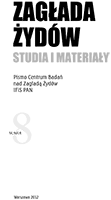Pamiętanie afektywne. Moim przyjaciołom Żydom Władysława Strzemińskiego
Kitsch Affective Remembrance. Władysław Strzemiński’s “To My Jewish Friends”
Author(s): Luiza NaderSubject(s): History
Published by: Stowarzyszenie Centrum Badań nad Zagładą Żydów & IFiS PAN
Keywords: Holocaust; art after 1945; Władysław Strzemiński; Litzmannstadt Ghetto; affect; guilt; shame; testimony; memory
Summary/Abstract: Władysław Strzemiński’s “Moim Przyjaciołom Żydom” (To My Jewish Friends) consists of ten collages. It was created right after World War II. Strzemiński did not date or sign the works. His works are collages of drawings, photos and expressive inscriptions. The interpretation proposed in the article bases on an attempt to identify the visual material and to analyze the relations between the text, drawing and photograph and on analyzing them in the political context of Poland in the late 1940s. All photographs Strzemiński used have a documental character. But they differ in the perspective from which they were taken. I would like to ask the following research questions. What can we see in the photos? Who took them and from what perspective? What is the connection between the photographer, the photographed and the viewer? In what way does Strzemiński’s cycle problematize the notion of the observer? In the article I try to metonymically read Strzemiński’s collages taking into account their materiality, the chain of meanings they create and the loops of gazes in the photos and their trajectories. I simultaneously determine the function of the “To My Jewish Friends” cycle in the context of the historical events taking place at that time (e.g. the Nazi war criminals’ trials or the Polish debates on Holocaust memory) while treating the collages not only as a testimony but also as a call for testimony addressed to the future. I also prove that the category of an affect (especially guilt and shame) is useful in the analysis of Strzemiński’s cycle and that in fact the works base on affectiveness and that they transmit specific affects. I ask what affects are the basis for Strzemiński’s cycle and what affects arise during their viewing. I reflect on their critical potential, the possibility to deal with them and the connection with memory and remembrance. My analysis reveals the category of “affective remembrance” of the Holocaust, which opens the present and the past to the horizon of hope and subject/political change.
Journal: Zagłada Żydów. Studia i Materiały
- Issue Year: 2012
- Issue No: 8
- Page Range: 188-213
- Page Count: 26
- Language: Polish

